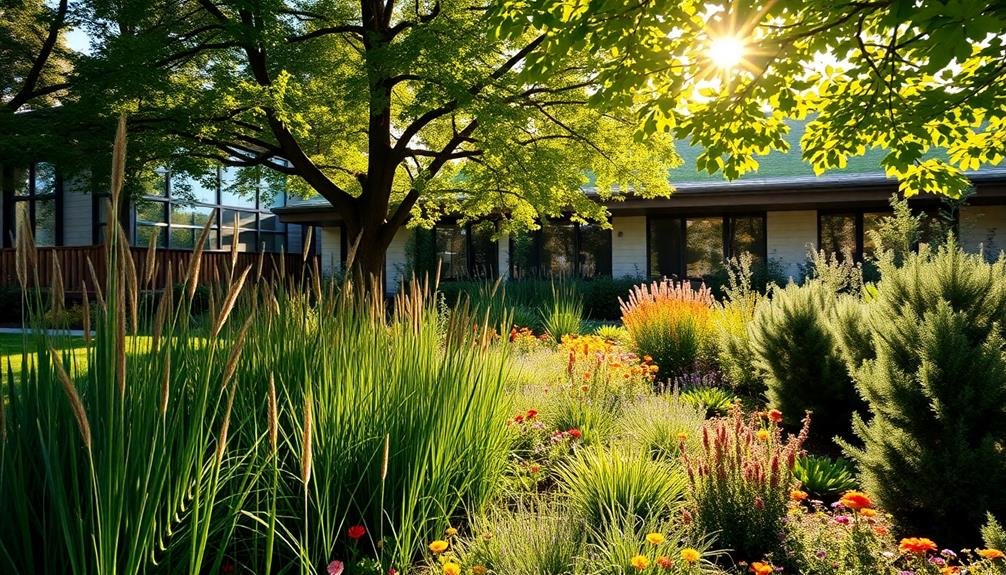Native plants can greatly boost your yard's energy efficiency. You'll want to start with shade trees like oaks and maples on the south and west sides of your home to reduce cooling costs. Add evergreen shrubs like American Holly for windbreaks and insulation. Don't forget drought-resistant groundcovers and water-efficient perennials to conserve water. Native vines can cool walls and windows, while native grasses help regulate soil temperatures. Combine different plant types for maximum benefit – like pairing deciduous trees with understory shrubs. By choosing the right native plants, you'll create a beautiful, eco-friendly landscape that saves energy year-round.
Native Trees for Shade

Nature's canopy offers an excellent solution for energy-efficient landscaping. By strategically planting native shade trees, you'll create a natural cooling system for your home. These trees can considerably reduce your energy costs by blocking the sun's intense rays during hot summer months.
Consider the oak family for its impressive shade coverage. White oaks, red oaks, and live oaks are excellent choices, depending on your region. They're hardy, long-lived, and provide dense canopies.
Maple trees, such as red maples or sugar maples, also offer substantial shade and vibrant fall colors.
For faster-growing options, look into river birches or American sycamores. They'll quickly establish themselves and provide ample shade.
If you're in a warmer climate, native magnolias or bald cypresses can offer year-round shade and unique aesthetics.
When planting, position these trees on the south and west sides of your home. This placement maximizes shade during the hottest parts of the day.
Remember to account for the tree's mature size and avoid planting too close to structures or power lines. With proper selection and placement, you'll create a cooler, more energy-efficient outdoor space.
Drought-Resistant Groundcover Options
Groundcover plays an essential role in energy-efficient landscaping, especially when you're dealing with drought-prone areas. Native drought-resistant groundcovers can help conserve water, reduce soil erosion, and maintain cooler temperatures around your home.
These low-growing plants create a living mulch that suppresses weeds and retains moisture, reducing the need for frequent watering and maintenance.
When choosing drought-resistant groundcover options, consider native species adapted to your region's climate. These plants will thrive with minimal care and contribute to your yard's biodiversity.
Some popular native groundcovers include:
- Creeping thyme (Thymus serpyllum)
- Stonecrop (Sedum spp.)
- Kinnikinnick (Arctostaphylos uva-ursi)
- Prairie smoke (Geum triflorum)
To maximize energy efficiency, plant groundcovers in areas where grass struggles to grow, such as steep slopes or shaded spots. You'll reduce water consumption and mowing needs while creating an attractive, low-maintenance landscape.
Remember to group plants with similar water requirements together and use mulch to further conserve moisture.
Energy-Saving Shrubs and Bushes

When selecting energy-saving shrubs and bushes, you'll want to contemplate both shade-providing evergreen options and wind-breaking deciduous varieties.
Evergreens can offer year-round insulation and cooling effects, while deciduous plants provide seasonal benefits.
You can strategically place these plants around your home to maximize their energy-saving potential, reducing your heating and cooling costs throughout the year.
Shade-Providing Evergreen Options
Evergreen shrubs and bushes offer year-round shade and energy-saving benefits for your home. These plants maintain their foliage throughout the seasons, providing consistent insulation and protection from the elements.
When strategically placed, they can greatly reduce your home's cooling costs in summer and heating expenses in winter.
Consider these native evergreen options for your landscape:
- American Holly: A dense, pyramidal tree that can grow up to 50 feet tall, providing excellent shade and wind protection.
- Eastern Red Cedar: A drought-tolerant conifer that thrives in various soil types and offers year-round screening.
- Mountain Laurel: A compact shrub with glossy leaves and beautiful spring flowers, perfect for shading smaller areas.
- Inkberry: A low-maintenance shrub that forms dense thickets, ideal for creating natural barriers and shade.
When planting these evergreens, focus on the west and northwest sides of your home to block harsh afternoon sun and winter winds.
You'll want to place them far enough from your house to allow for growth while still providing effective shade.
Wind-Breaking Deciduous Varieties
Unlike their evergreen counterparts, deciduous shrubs and bushes offer unique wind-breaking benefits while allowing for seasonal versatility.
These native plants can greatly reduce your home's energy consumption by blocking cold winter winds and providing cooling shade in summer.
Consider planting serviceberry, a hardy shrub that forms dense thickets to break wind. Its white spring flowers and edible berries add visual appeal.
Witch hazel is another excellent choice, with its late-fall blooms and ability to thrive in various soil conditions.
For taller options, try American hornbeam or hop hornbeam, both of which develop thick canopies to disrupt airflow.
To maximize wind protection, plant these shrubs in staggered rows on the north and northwest sides of your property.
This arrangement creates a natural windbreak that can lower your heating costs by up to 30% in winter.
In summer, their leafy canopies provide shade while allowing cooling breezes to pass through.
Don't forget to incorporate native berry-producing shrubs like elderberry or blackberry.
These not only serve as effective windbreaks but also attract wildlife and provide you with fresh fruit.
Windbreak Plants for Insulation
Windbreak plants serve as a natural shield against harsh winds, effectively insulating your home and reducing energy costs. By strategically planting these native species around your property, you'll create a barrier that deflects cold winter winds and hot summer breezes.
This natural insulation can greatly lower your heating and cooling expenses while enhancing your landscape's aesthetic appeal.
When selecting windbreak plants for insulation, take into account evergreen varieties that maintain their foliage year-round. These plants provide consistent protection and are particularly effective in colder climates.
Opt for species native to your region, as they're already adapted to local conditions and require less maintenance.
Here are some popular native windbreak plants to take into account:
- Eastern Red Cedar: Dense, columnar growth ideal for narrow spaces
- American Holly: Attractive berries and glossy leaves for year-round interest
- Leyland Cypress: Fast-growing and drought-tolerant once established
- Northern White Cedar: Cold-hardy and resistant to deer browsing
Plant your windbreak in a staggered, multi-row formation for maximum effectiveness.
Position taller species in the center, with shorter plants on the outer edges. This arrangement creates a gradual slope that efficiently redirects wind over and around your home, optimizing its insulating properties.
Native Vines for Cooling

Nature's own air conditioning system, native vines offer an eco-friendly solution for cooling your home. These climbing plants create a natural barrier against the sun's heat, reducing your need for artificial cooling. By shading walls and windows, they can lower indoor temperatures by up to 20 degrees Fahrenheit.
Consider planting Virginia creeper, a fast-growing vine that thrives in various climates. Its dense foliage provides excellent coverage and turns vibrant red in fall.
Trumpet honeysuckle is another great option, attracting pollinators while offering shade. For southwestern regions, canyon grape is an ideal choice, tolerating drought and intense sun.
When planting vines, make certain they've proper support structures like trellises or lattices. This prevents damage to your home's exterior while maximizing their cooling capability. Plant them on the south and west sides of your house for best sun protection.
Remember to maintain your vines regularly. Prune them to control growth and prevent them from interfering with gutters or roofing.
With proper care, these native vines won't only cool your home but also enhance its aesthetic appeal, creating a lush, energy-efficient landscape.
Water-Efficient Perennial Flowers
Water-efficient perennial flowers offer a sustainable way to beautify your garden while conserving resources. These native plants have adapted to your local climate, requiring less water and maintenance than non-native species. By choosing water-efficient perennials, you'll reduce your water bills and create a more environmentally friendly landscape.
When selecting water-efficient perennial flowers, evaluate your region's specific climate and soil conditions. Look for plants with deep root systems, which can access water from further below the surface. Many native flowers have evolved to thrive in drought conditions, making them ideal choices for water conservation.
Here are some popular water-efficient perennial flowers to evaluate:
- Black-eyed Susan (Rudbeckia)
- Coneflower (Echinacea)
- Blanket Flower (Gaillardia)
- Yarrow (Achillea)
To maximize the benefits of these plants, group them according to their water needs. This practice, known as hydrozoning, allows you to water more efficiently.
Mulch around your perennials to retain moisture and suppress weeds. With proper planning and care, you'll enjoy a vibrant, low-maintenance garden that conserves water and enhances your yard's energy efficiency.
Native Grasses for Temperature Control

Native grasses offer an excellent solution for natural temperature control around your home. These hardy plants have deep root systems that help stabilize soil temperatures and reduce heat absorption. By planting native grasses strategically, you'll create a natural barrier that insulates your house from extreme temperatures.
Consider using tall prairie grasses like big bluestem or switchgrass along the south and west sides of your property. These grasses can grow up to 6-8 feet tall, providing shade and reducing solar heat gain on your home's walls and windows.
For areas closer to your house, opt for shorter varieties like little bluestem or buffalo grass, which form dense mats that insulate the ground and prevent heat from radiating towards your foundation.
Native grasses also help regulate moisture levels in the soil, which can further impact your home's temperature. Their extensive root systems improve soil structure, allowing for better water retention and reducing the need for irrigation.
This natural cooling effect can lower your energy costs by decreasing the workload on your air conditioning system during hot summer months.
Evergreens for Year-Round Protection
You'll find that native evergreens offer outstanding year-round protection for your home.
These hardy plants serve as effective windbreaks, reducing cold air infiltration in winter and providing insulation benefits throughout the seasons.
For ideal results, consider planting species like Eastern Red Cedar, White Pine, or Norway Spruce, which are well-adapted to various climates and offer dense foliage for maximum protection.
Windbreak and Insulation Benefits
Evergreen windbreaks offer year-round protection and energy-saving benefits for your home. By strategically planting native evergreen trees and shrubs, you'll create a natural barrier that shields your property from harsh winds and extreme temperatures.
This living windbreak can remarkably reduce your heating and cooling costs while enhancing your home's comfort.
When planted on the north and northwest sides of your property, evergreens act as a buffer against cold winter winds. They'll slow down air movement, creating a pocket of still air that insulates your home.
In summer, these same trees provide shade and cool the air around your house, reducing the need for air conditioning.
Consider these native evergreen options for your windbreak:
- Eastern Red Cedar
- White Pine
- American Holly
- Leyland Cypress
Choose species that are well-adapted to your local climate and soil conditions. Plant them in staggered rows for maximum effectiveness.
As your windbreak matures, you'll notice improved energy efficiency and a more comfortable living environment.
Plus, you'll enjoy the added benefits of increased privacy, reduced noise pollution, and enhanced wildlife habitat in your yard.
Best Evergreen Species
Majestic sentinels standing guard year-round, the best evergreen species for energy efficiency offer more than just aesthetic appeal.
They're your home's natural armor against harsh weather, providing insulation and wind protection throughout all seasons.
For maximum energy-saving benefits, consider planting native evergreens like Eastern Red Cedar, White Pine, or Norway Spruce.
These hardy species thrive in various climates and create effective windbreaks.
Eastern Red Cedar, with its dense foliage, excels at blocking winter winds and reducing heating costs.
White Pine grows tall and wide, offering expansive coverage for larger properties.
Norway Spruce, known for its rapid growth and conical shape, forms an excellent barrier against cold drafts.
In warmer regions, you'll find Southern Magnolia and Live Oak to be ideal choices.
Their broad, thick leaves provide excellent shade in summer, reducing cooling needs.
For smaller spaces or as foundation plantings, consider Arborvitae or Yew.
These compact evergreens create a tight insulation barrier close to your home's walls, minimizing heat loss in winter and heat gain in summer.
Beneficial Native Plant Combinations

When planning your energy-efficient landscape, combining native plants strategically can maximize benefits.
Consider pairing tall deciduous trees with lower-growing shrubs and groundcovers. This combination provides summer shade while allowing winter sunlight to warm your home. For example, oak trees paired with native ferns and wildflowers create a multi-layered ecosystem that regulates temperature and moisture.
In windier areas, mix evergreen trees with dense shrubs to form an effective windbreak. Native conifers like spruce or pine, combined with hardy shrubs like viburnum or dogwood, can greatly reduce heating costs.
For hot, sunny spots, combine drought-tolerant grasses with flowering perennials. This pairing helps conserve water and creates habitat for pollinators.
To enhance your yard's energy efficiency, try these native plant combinations:
- Oak trees + ferns + wildflowers for shade and biodiversity
- Spruce or pine + viburnum or dogwood for windbreaks
- Prairie grasses + coneflowers for water conservation
- Maple trees + understory shrubs for temperature regulation
Frequently Asked Questions
How Do Native Plants Impact Local Wildlife Populations?
Native plants profoundly impact local wildlife populations. You'll find they provide essential food sources, nesting materials, and shelter for various species. They've evolved alongside local fauna, creating a symbiotic relationship that supports biodiversity in your area.
What Are the Best Methods for Maintaining Native Plants in Urban Environments?
You'll succeed in maintaining native plants in urban areas by using organic fertilizers, mulching regularly, and watering deeply but infrequently. Prune only when necessary, control pests naturally, and group plants with similar needs together for ideal care.
Can Native Plants Help Reduce Air Pollution in Residential Areas?
Yes, native plants can help reduce air pollution in your neighborhood. They're natural air filters, absorbing pollutants and releasing oxygen. You'll improve air quality by planting native trees, shrubs, and flowers in your yard and community spaces.
Are There Any Native Plants That Can Be Harmful to Pets?
Yes, some native plants can be harmful to pets. You'll want to avoid toxic species like foxglove, azaleas, and daffodils. Always research plants before adding them to your yard if you have curious pets.
How Do Native Plants Affect Soil Quality and Erosion Control?
You'll find native plants improve soil quality by adding organic matter and nutrients. They're excellent for erosion control too, as their deep root systems stabilize soil, prevent runoff, and increase water absorption. You'll see better soil health overall.
In Summary
You've now got a great selection of native plants to boost your yard's energy efficiency. By incorporating shade trees, drought-resistant groundcover, energy-saving shrubs, windbreaks, cooling vines, water-efficient flowers, temperature-controlling grasses, and protective evergreens, you'll create a more sustainable and cost-effective landscape. Don't forget to combine these plants strategically for maximum benefit. With these native options, you'll enjoy a beautiful yard that works hard to reduce your energy consumption and bills.





Leave a Reply